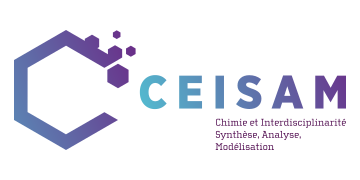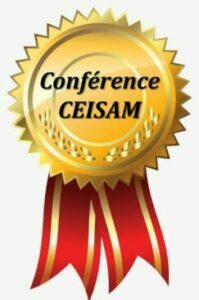La conférence #3 labellisée CEISAM de Lyndon Emsley aura lieu le jeudi 8 Décembre 2022 à 10h00. Pr. Lyndon Emsley est un chimiste renommé dans le domaine de la la caractérisation de solides moléculaires, tels que des composés pharmaceutiques, et hybrides, tels que des perovskites hybrides, ainsi que le développements de méthodes RMN et des outils de prédiction/analyse associés, incluant des approches de machine learning. Lyndon Emsley est directeur de l’institut de chimie à l’EPFL, éditeur associé du JACS et lauréat ERC advanced.
Structure determination by NMR Crystallography,
from molecular solids to hybrid materials
Structure elucidation of amorphous materials and microcrystalline solids is one of the key
challenges in chemistry today. While techniques such as single crystal diffraction and cryo-
electron microscopy are generally not able to characterize such materials, we will show how an
approach based on measured NMR chemical shifts in combination with methods for large scale
computation of shifts can rapidly determine full three-dimensional structures from powders.
For example, using a machine learning model of chemical shifts, we determine the complete
atomic-level structure of the amorphous form of a drug molecule by combining dynamic
nuclear polarization-enhanced solid-state NMR experiments with chemical shifts predicted
using machine learning for MD simulations of large systems.(1,2) From these amorphous
structures we then identify H-bonding motifs and relate them to local intermolecular
interaction energies. In other examples, we will show how chemical shift driven NMR
crystallography can be applied to determine the complete three-dimensional structures of
challenging complex materials such as calcium-silicate-hydrates,(3,4,5) or hybrid organic-
inorganic photovoltaic perovskites.(6,7,8)
Publications
1. Paruzzo, et al., “Chemical shifts in molecular solids by machine learning.” Nat Commun 2018, 9, 4501.
doi.org/10.1038/s41467-018-06972-x
2. Cordova, et al., “Structure determination of an amorphous drug through large-scale NMR predictions.” Nat
Commun 2021, doi.org/10.1038/s41467-021-23208-7
3. Kumar, et al., ”The Atomic-Level Structure of Cementitious Calcium Silicate Hydrate,” J. Phys. Chem. C 121,
17188 (2017).
4. Mohamed, et al., “The Atomic-Level Structure of Cementitious Calcium Aluminate Silicate Hydrate,” J. Am.
Chem. Soc. 142, 11060 (2020).
5. Morales-Melgares, et al., “The Atomic-Level Structure of Zinc-Modified Cementitious Calcium Silicate
Hydrate,” J. Am. Chem. Soc. in press.
6. Hope, et al., “Nanoscale Phase Segregation in Supramolecular pi-Templating for Hybrid Perovskite
Photovoltaics from NMR Crystallography,” J. Am. Chem. Soc. 143, 1529 (2021).
7. Jeong, et al., “Pseudo-halide anion engineering for alpha-FAPbI(3) perovskite solar cells,” Nature 592, 381
(2021).
8. Kubicki, Stranks, Grey, Emsley, “NMR spectroscopy probes microstructure, dynamics and doping of metal
halide perovskites,” Nat. Rev. Chem. 5, 624 (2021).
Biography
Lyndon Emsley is a Professor of Chemistry at EPFL, where he develops new
methods in NMR spectroscopy. he graduated from the Imperial College of Science and
Technology in London in 1986, Lyndon Emsley completed a PhD at the Université de Lausanne
in 1991 doing NMR spectroscopy of solutions with Geoffrey Bodenhausen. He then moved to
the University of California Berkeley as a Fellow of the Miller Institute for basic Research in
Science, working with Alex Pines, where he was introduced to solid-state NMR. In 1993 he
moved to the French National Laboratory for Atomic Energy Research in Grenoble, and in 1994
he was appointed to a Professorship at the Ecole normale supérieure in Lyon. He was Head of
the Experimental Chemistry Laboratory from 1999 to 2002, and Head of the Chemistry
Department from 2006 to 2012. He became a member of the Institut Universitaire de France in
2002. In 2003 he was made the project leader for the creation of a European Laboratory for
Very High Field NMR, which was completed in 2008, with the delivery of the world’s highest
field high-resolution NMR spectrometer, operating at 1 GHz. He moved to the EPFL and became
a Professor of Physical Chemistry in June 2014 and Head of the Laboratoire de RMN. He was
director of the Institute of Chemical Sciences and Engineering (ISIC) from 2016 to 2020.
Contact: jean-nicolas.dumez@univ-nantes.fr

